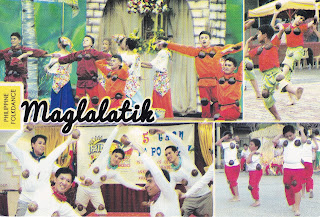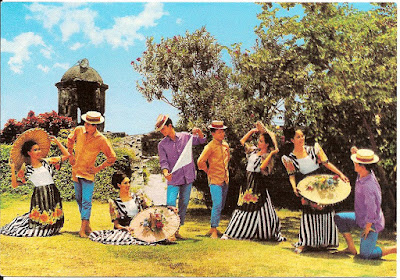Cariñosa means loving or affectionate one, is a Philippine folk dance of colonial era origin from the Maria Clara suite of Philippine Folk Dances. A fan or a handkerchief is used to portray a dancing couple in a romantic scenario. This dance originated in Panay Island of the Visayan Islands and was introduced by the Spaniards during the colonization period. It is related to a Spanish dance like Bolero and a Mexican dance, the Jarabe Tapatio or the Mexican Hat Dance.
~•✿•~ ~•✿•~
ITIK-ITIK is one of the most popular Filipino Folk Dances. It depicts movements of a Swan or a Duck.
~•✿•~ ~•✿•~
KUMINTANG - The graceful hand movements from the wrist going clock or counterclockwise while dancing. This is a typical characteristic movement of the hands in Philippine Folk Dances.
~•✿•~ ~•✿•~
The MAGLALATIK is an indigenous dance from the Philippines in which coconut shell halves are secured onto the dancers' hands and on vests upon which are hung four or six more coconut shell halves. The dancers - all male - perform the dance by hitting one coconut shell with the other - sometimes the ones on the hand; sometimes the ones on the body, and sometimes the shells worn by another performer, all in time to a fast drumbeat. Like many native Filipino dances, it is intended to impress the viewers of the great skills of the dancers; even some Filipino Martial Arts circles. It has been noted that the MAGLALATIK "consists of a trapping and boxing method hidden in a dance."
~•✿•~ ~•✿•~
PANDANGGO SA ILAW is another popular folk dance in the Philippines which was said to have originated from the Island of Mindoro. This DANCE OF LIGHTS simulates fireflies at dusk and at night. The word pandanggo came from the Spanish fandango, a dance in 3/4 time beat. The phrase "sa ilaw" is Tagalog word means "in the light", and is referred to the three oil lamps that a dancer has to balance - one on the head and one on the back of each hand. The oil lamp is called tinghoy. Sometimes, lighted candles inside the glasses are used instead of the oil lamp.
~•✿•~ ~•✿•~
SINGKIL or Sayaw sa Kasingkil - is a Royal Muslim Folk Dance of the Maranaos (from Lanao)based from the epic legend of Darangen. This dance is performed with quick steps through crisscrossed bamboo poles to the rhythm of brass gongs.
~•✿•~ ~•✿•~
The TINIKLING is the most popular and well-known traditional Philippine Folk Dance. It is an old pre-Spanish colonial dance that involved two people beating, tapping, and sliding bamboo poles on the ground and against each other in coordination with one or more dancers who step over and in-between the poles as they dance. This dance originated in Leyte in the Visayan Islands of central Philippines - as an imitation of the tikling bird dodging bamboo traps set by rice farmers. The dance imitates the movement of the tikling birds as they walk between grass stems, flit on tree branches or dodge bamboo traps. Dancers imitate the birds' legendary grace and speed by skilfully maneuvering between large bamboo poles. They wear no footwear, but bare feet as they perform.
~•✿•~ ~•✿•~ ~•✿•~ ~•✿•~ ~•✿•~ ~•✿•~FROM OTHERS
PANDANGGO STA CLARA or OBANDO DANCE is a fertility dance popular in Bulacan. The dancers hope to find a wife, a husband, or a child.
SAKUTING - a folk dance of the Ilocanos usually performed during Christmas. Groups of boys and girls go to perform from house to house receiving many gifts in return. Note the two sticks used to produce the rhythmic sound. (Baranggay Folk dance Troupe Philippine Normal College).
"OBANDO" named after a town in Bulacan. Obando Dance is a dance of rural Philippines. Attire is the native "balintawak" and "salakot" for the ladies and "barong tagalog and "buntal" hats for the gentlemen.
PANDANGGO STA CLARA or OBANDO DANCE is a fertility dance popular in Bulacan. The dancers hope to find a wife, a husband, or a child.
SAKUTING - a folk dance of the Ilocanos usually performed during Christmas. Groups of boys and girls go to perform from house to house receiving many gifts in return. Note the two sticks used to produce the rhythmic sound. (Baranggay Folk dance Troupe Philippine Normal College).
KUMENTANG - The graceful hand movements from the wrist going clock or counter clockwise while danding. this is atypical Characteristic movement of the hands in Philippine folk dances.
Native dresses brightens the countryside during harvest time. In the background is the world's most perfect cone-shaped volcano, THE MAYON.











